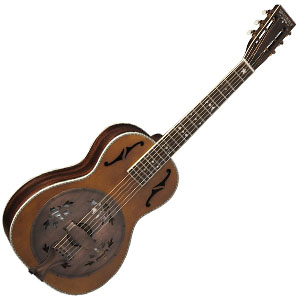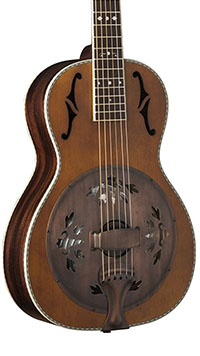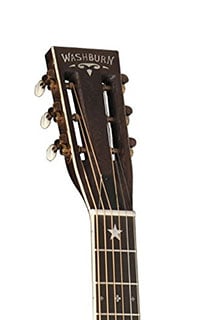- Home
- Instruments
- Gear
- Recording
- Lessons
- Reviews
- Blog


| Body And Neck: |  |
| Hardware: |  |
| Sound: |  |
| Value: |  |
Although the R360K looks like something you may have found in your great grandfather’s attic, it’s actually from a relatively new line of resonator parlors from Washburn. The resonators in this series boast timeless vintage looks and a couple of solid appointments that make the R360K a fine addition to our chart of the top resonators on the market. Let’s see what this cute roundneck resonator has to offer!

The R360K is just a beautiful instrument, especially if you like the rough n’ ready rustic look – this resonator has it in truck loads. With a compact 24.75” scale length non-cutaway body, the top is made from spruce, while trembesi makes up the back and sides – both woods looking aged and distressed. The elaborate f-holes are eye-catching, as is the intricate multi-ply binding on the top and back of the guitar.
The wide mahogany neck is very nice to play for both fingerstyle or slide players (in a regular position), and is finished in satin with a rosewood fretboard. This has 18 frets (12 in the clear), marked by 1890’s ‘fancy style’ pearl inlays, which just add to the cool vintage appeal of the guitar, while the slotted headstock oozes tradition. Ultimately this guitar has been designed to look like an early 20th Century model, and it succeeds.

Washburn justifies the R360K’s slightly higher price tag with a host of worthwhile appointments. There’s a good-quality biscuit resonator cone and rosewood bridge, featuring a decorative antique bronze coverplate (which includes easy bridge access – very convenient). This nicely matches the distressed bronze tuners, while a bone nut sits just below. The tuners – with aged plastic buttons – are fine and feel very sturdy, but they can be a little stiff in practice. Finally, the R360K comes strung with D’Addario’s EJ42 Resophonic light gauge strings, and also arrives in its own hardshell case (not the most attractive, but it does the job!), which is a decent addition.
If you’re looking for character in tone, the R360K has plenty of it. Similar to mahogany, the trembesi offers a dark, woody tone, while the spruce keeps things balanced and articulate. The guitar’s projection is good too – quieter than your regular resonator guitar, but the biscuit cone provides a boost to the volume, with a twangy and gritty sound that’s just perfect for classic folk and blues playing.
A lot of effort has been put in to making this parlor guitar a vintage treat for both the eyes and ears, and Washburn’s hard work has not gone unnoticed – we love it. The design is certainly a talking point, while it ensures it’s a guitar you’d be very happy performing with – whether that’s on a stage or on the front porch. Overall, it justifies its mid-range price tag, and is a nice alternative to some of the other more standard resonators we’ve featured.
For more info about the Washburn R360K Parlor Resonator, click here.
For more Resonator Guitars you might like, click here.

Paul E Suffridge says
This guitar definitely isn’t for everyone. That being said, it’s the guitar I’ve been looking for all my life. I’m a fingerpicker and I don’t play slide. The 1 7/8″ nut and 24 3/4″ scale are a blessing and I attained a supreme level of comfort immediately upon picking it up the first time. The first comment my brother said when I played it for him was “We’ve been hoping you’d find that guitar someday.”
It is simply a beautiful, well crafted instrument. For what I do it is perfect. I can’t say enough words to express my joy in owning this work of art.
If you are a solo guitarist/singer this guitar is worth consideration. It is now my main axe and it has cured my G.A.S.
Paul E Suffridge says
Also, concern has been expressed over some of these being understrung on the tailpiece. This is happening because the tailpiece is difficult to string properly. It is NOT because of a design flaw. My solution is to break the tip off of a bamboo skewer and lightly wedge the string into the bridge slot to keep it seated whilst I deal with things on the post and nut ONE STRING AT A TIME.
Ross MacKinnon says
Hi Paul, I very recently acquired a pre-owned R360k and your comments have been very useful, especially regarding your method of restringing the tailpiece!
I agree it’s a beautiful little guitar and I find it odd that it seems to be relatively overlooked.
I intended to use it for slide, tuned to open D, as I have another parlor guitar I use for fingerstyle (Gretsch Jim Dandy). However I just seem to find fingerpicking in standard tuning a bit more enjoyable and this is where the R360k really shines!
As a fingerpicker yourself, can I ask what gauge strings you find works best on this guitar? Also, did you have to alter the height of the bridge saddle at all? The string height on mine is relatively high, about 3mm on the low E, 2.5mm on high E.
Thanks once again for your comments 🙂